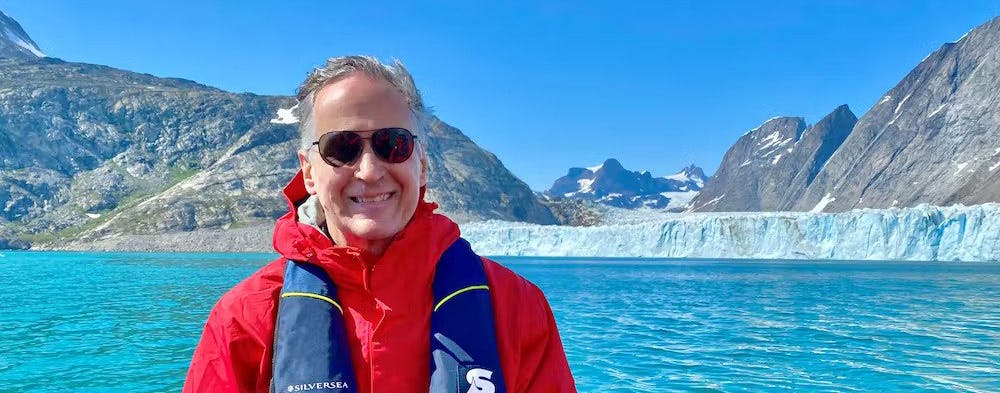Ignacio Maza Has Traveled Almost Everywhere But Arctic Greenland. Until now
Ignacio Maza’s passion for far-flung places has inspired his career as executive vice president of Signature Travel Network, a consortium of travel agencies. As well, his self-admitted sense of wanderlust for travel near and far has taken him to more than 100 countries. He’s sailed on 80-plus cruise ships.
And yet, he’d never made it to Arctic Greenland. At least until this past summer, when he cruised on Silversea’s Silver Wind. What took so long to get there? And was it finally worth it? Silversea contributor David Swanson, equally afflicted by both the travel bug and a love for icy frontiers, reached out to him to compare notes.
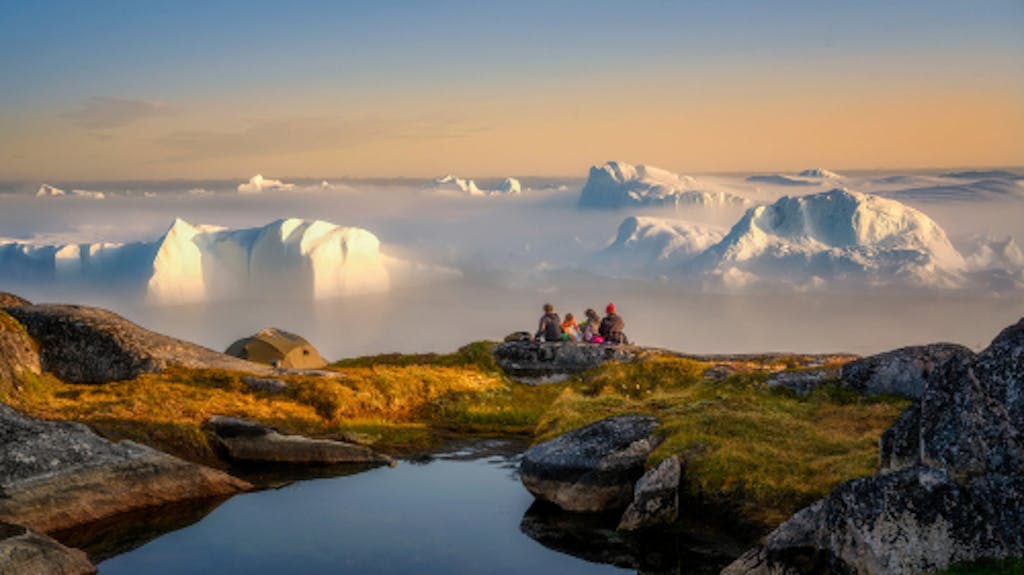
David Swanson: I was fortunate to first visit Greenland in 2008. At that time, I didn’t know anyone who had been there, and social media hadn’t blown it up. For a land-based trip it was such an extreme and expensive destination that it seemed no one other than Larry Page and Sergey Brin had been there. What lured you to Greenland?
Ignacio Maza: It was just so far away, so unreachable, such a distant, interesting place. And I was fascinated to learn about the Inuit culture that has figured out a way to live in this very hostile environment. Before the trip I really struggled to find a good reference book. There isn’t a lot written about Greenland and the only thing I could find on it was a very plain brochure that basically told me nothing I didn’t already know. For me, Greenland was a question mark, and I love question marks. I love being in the middle of nowhere, and going to places that other people don’t visit — that feeling that I’m the first one there, which of course isn’t true. But you know that that sense when you feel you are a pioneer, that you’re discovering something new? That is incredibly appealing to me.
DS: Today, there seems to be real curiosity about Greenland, especially from TV series like Borgen being filmed there. Do you think that, as a travel destination, Greenland is having its proverbial moment in the sun?
IM: Absolutely. I think a lot of people have already discovered Iceland — it was kind of the “it” place to go a few years ago. But people are very curious about the next frontier, and Greenland has so much going for it with the convergence of a number of things. One is the fact that it remains undiscovered to most people. Each year I write a column for our members and clients, about where to go in the following year. Greenland is absolutely on my list.
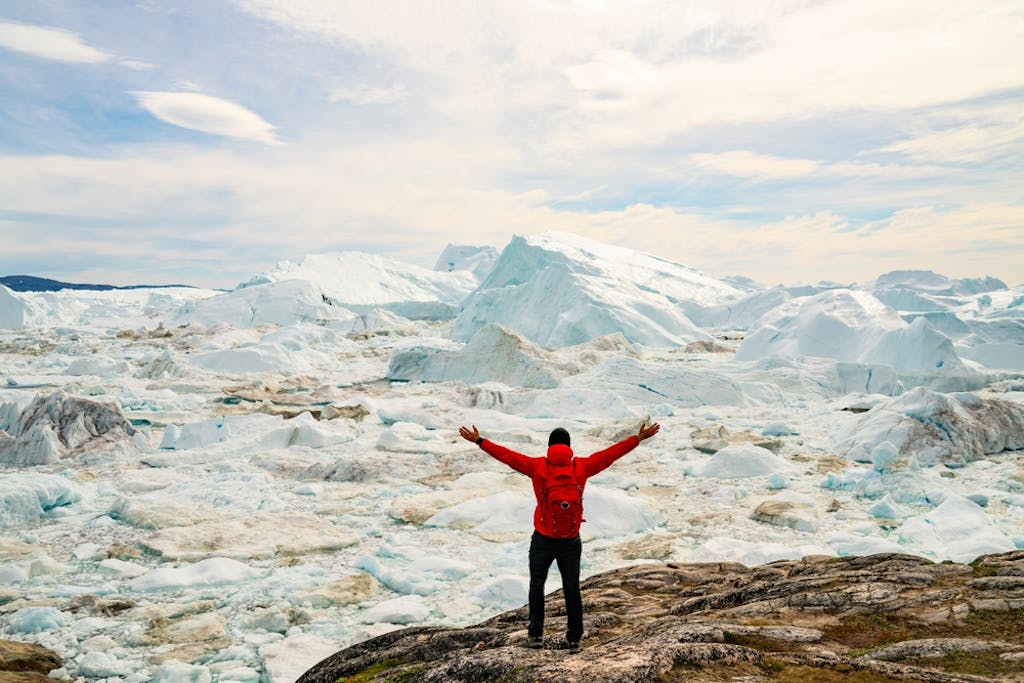
No. 2 is that it’s front and center in the whole question of global warming — because you see it with your own eyes. Did you read the recent article in the New York Times by Bret Stephens? He did not believe in global warming, but then a scientist took him to Greenland. He went to Ilulissat and he came back and said, ‘I get it, I understand, I see the urgency of this, happening in front of our very eyes.’
And then, thirdly, is the fact that you have so many cruises going to that part of the world, probably more than ever before. You’ve got Seabourn, Lindblad, Quark, and you’ve got Silversea. So there are many ways to experience the destination. Yes, definitely — Greenland is absolutely having its moment.
DS: Given the variety of cruise lines calling on Greenland today, what made your Silversea experience stand out?
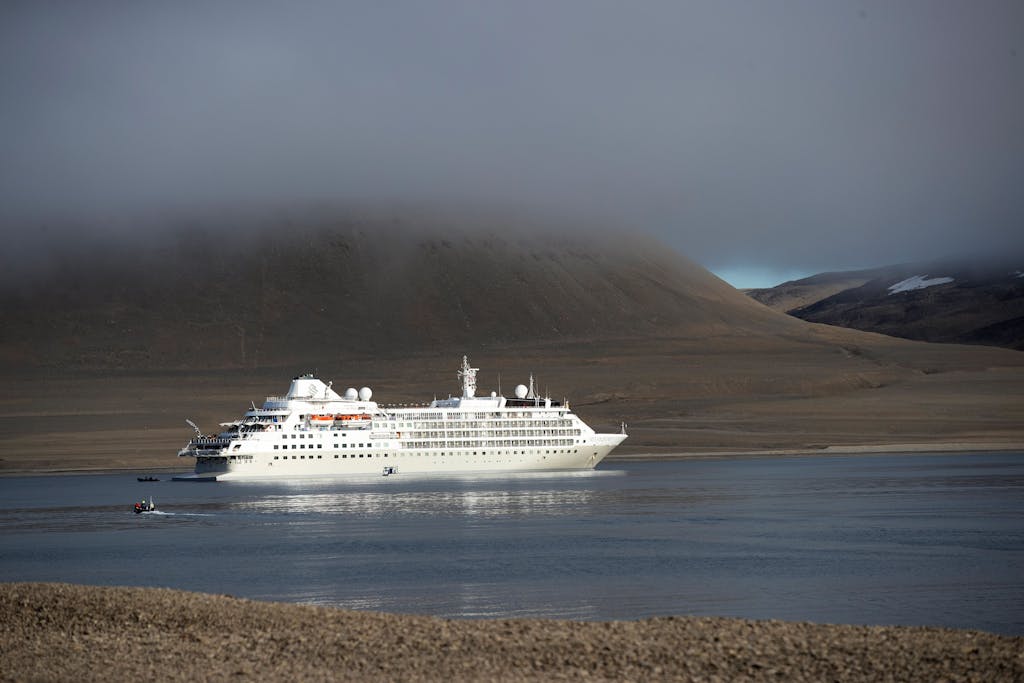
IM: First of all, the ship. I was so impressed with the Silver Wind because of the stability. I was apprehensive about the rolling motion in the open ocean, especially on the segment from Iceland to Greenland where you have to cross the Denmark Strait. Although we had some pretty interesting waves, the ship was very, very steady just because of the way it has been designed. The ship was refitted as an expedition ship last year, and a ducktail was added that has given the vessel more stability. And the way the ship is designed with all the deck space, it never felt crowded. If you wanted to go on deck to spot whales, there was always plenty of room for everybody. Number two is the itinerary which, aside from one day at sea, was very port intensive. We were looking at landscapes and going into fjords and stopping in towns just about every day.
Next is the quality and the depth of the expedition team. I mean, these people were really, really knowledgeable. And what I liked is that every one of them was so different. There was a lady who was an expert on whales, and she did a lecture on whales one day and about 75 people showed up in the theater at 10 o’clock in the morning. Other expedition members on the team know about birds, or about ice, and the history of Greenland. People are really curious and they want to learn, so you had this whole enrichment component that was so wonderful — and about a destination that we don’t know a great deal about.
In addition, you have every creature comfort on board. You have a wonderful staff looking after you, and a very comfortable stateroom. The heated pool was one of my favorite spots on the ship — just to be able to come back from an adventure and put on your swimsuit and jump in that pool was terrific. So it’s the unique combination of comfort with adventure, enrichment, service all rolled up into one voyage.
DS: What does Greenland offer that someplace like Antarctica or Iceland doesn’t?
IM: In fact, my boss asked me that same question. As I tried to explain to him, it’s chalk and cheese — they’re two completely different worlds. Iceland is very new, because it was settled so recently. Fifteen hundred years ago there was nobody in Iceland, because humans hadn’t gotten there yet. But there have been people living in Greenland for thousands of years, so it’s a culture that goes back much, much further.
Then there’s the fact that you have a very different terrain, because most of Greenland is this enormous ice sheet and Iceland is a series of valleys. Yes, you’ve got some ice fields, but most of Iceland is not an ice field. In fact, I think the Vikings got screwed up and the names should be reversed! The other thing is that you really have to stay on the coast when you go to Greenland, whether you like it or not, because there are no roads, there is no way to cross the ice field from east to west — unless you’re Knud Rasmussen and go out with a sled and a pack of dogs!

Also, in Antarctica you have this incredible abundance of wildlife — you hear the penguins long before you get to the shore, you’ve got elephant seals, the whales, and all this marine life around, no matter where you are in Antarctica. You don’t have that in Greenland, and you don’t have the bird life that you have in Iceland. Greenland is about silence, it’s about being in this kind of absolute white space. You know, just rocks and ice and that’s it. There were days when we didn’t see a bird or a fish or a whale or anything. It’s all about the sea, spectacular landscapes, dramatic coastlines, ice formations, small Inuit communities, and that’s it.
DS: Why do you think someone want to visit someplace so uninhabited?
IM: My goodness — because it puts everything in perspective! It makes us realize how insignificant we are in in front of this all-powerful nature — that is so humbling. It puts you in the right place to see how we are completely insignificant, just like a grain of sand in this enormous ocean. When you see the mountains, when you see the fjords, when you see the glaciers, when you see the majesty of the ice cap, you’re reminded of what really matters.

I also think what was so moving to me were the people who have managed to live their lives in the face of such tremendous adversity. Because it’s winter three-quarters of the year, almost, and yet they manage, they endure, they persevere, they thrive, and they pass on their traditions and culture from generation to generation. In Greenland you will see these coastal communities, especially in the south and on the west coast. They have this absolutely impossible language, with only 18 letters and words that are 14 letters long!
DS: What were some of the standout moments of your trip?
IM: We came in from Iceland, so we first hit this fjord and a beautiful glacier at Skjoldungen on the east coast of Greenland. We had beautiful weather and it was spectacular. Another highlight was Kujataa, seeing the remnants of the Viking colonies. It’s very, very moving — a UNESCO World Heritage Site next to the sea and you see the stone churches and where people lived for years and years. I thought that was amazing. I loved the small villages and seeing the homes painted different colors and the people going by.
DS: I know you visited Ilulissat, which I found to be simply spectacular. It’s a small town right next to a fjord with one of the busiest glaciers in the world.

IM: Ilulissat absolutely blew me away. I don’t think that anything compares, even the glaciers in Alaska, to the sheer production of ice every single day, pushing the ice out into this fjord. I mean, I have been to a lot of different places, including Antarctica, but I have never seen anything like Ilulissat before. It’s a UNESCO World Heritage Site, and it is a place that must be seen — and I think for everybody on the voyage it was the top highlight. There’s also the cultural component to it, because this place has been revered by the local Inuit people for centuries. In fact, I think the Greenlandic word for iceberg is ilulissat.
The challenge with Ilulissat is that you only are there for one day and you have to choose if you want to do the helicopter to the glacier, or the boat ride out to the ice fjord. Or you can do the hike, which was a couple of miles to a visitor center where you see the history of the site and how the ice field is changing with global warming. Then there were these boardwalks that take you to a high point where the ice field is in front of you and goes out to infinity. That was incredibly impressive.
The schedule allowed us to pick two activities in Ilulissat. That day the weather was not terrific, and I knew the helicopter was iffy, so I chose the hike and the boat tour. The boat trip took us out into the ice fjord where you see the giant icebergs, some of them with waterfalls coming down the sides. We saw a pod of whales — going in, ducking under the icebergs, which I thought was just amazing. And then in the afternoon I hiked to the edge of the town, to the visitor center, and then onto the boardwalk. People who did the helicopter flight thought it was fantastic and they loved being able to land on top of the ice, but again, you have to choose. In Greenland the weather can turn on the dime, but if I went back I would do the helicopter.
DS: I found my kayaking experience in Greenland to be extraordinary. Tell me about yours.
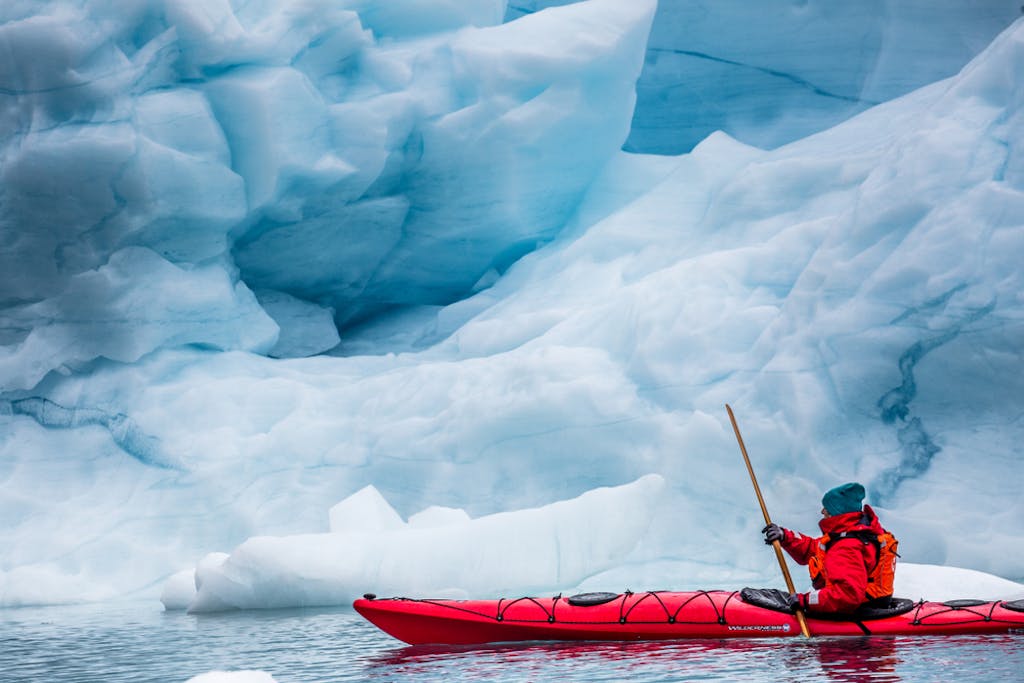
IM: Kayaking was absolutely a highlight. I have done sea kayaking previously, but obviously, kayaking in Greenland is in a whole other galaxy. There’s a sense of adventure about the whole thing. The other thing you need to know is that the kayaking is very limited onboard, and many people on my voyage wanted to kayak. There’s a lottery each day, and if your name gets pulled, you get to kayak. Once you have kayaked your name is taken out of the lottery, so everyone gets a chance as the cruise progresses. My turn came up towards the end of the cruise, at the Evighed Glacier.
DS: Ah, I kayaked there. I was amazed how comfortable and warm I was, despite being surrounded by ice.
IM: Well, the element of adventure kind of gets taken up to another notch, because of all the gear that you have to wear in Greenland. It’s a double kayak, and I’m used to kayaking by myself, so I had to learn how to navigate with another person, but we had a lot of fun. The other thing that you have to navigate is the currents, which as you know, can be very strong. We got our adrenaline going and went close to the wall of ice in the glacier, and to different parts of the fjord where we actually saw some birds. But I thought the expedition leader did a wonderful job corralling us and making sure that we always were safe. I feel very privileged to have gone.
There were many other highlights as well. I also loved the museum in Nuuk, where you get to see the heritage of the culture over the years and the mummies that were frozen.
DS: Would you call this a scenic cruise? How would you recommend this to your friends?
IM: It’s not an easy pitch, because, number one, it’s just so weather dependent. Number two, it is a combination of scenery and culture. There’s the cultural component experiencing the living Inuit culture in the villages, in the museums, and when you see the Viking sites. Then there’s the scenic component, and also the geographic component, for lack of a better word. Just knowing that you are at the edge of the world, at this island — that it’s the closest landmass to the North Pole and that many parts of it are still undiscovered, untrammeled. We have other places perfectly mapped and charted and visited and all the rest, but we don’t know everything there is to know about Greenland.
This isn’t for first timers [writer’s note: Ignacio essentially was trying to say: if you’ve never been on a cruise, don’t start with this one, it’s for people with experience] so I was really impressed with the people I had the opportunity to meet onboard the Silversea cruise. They were probably the best traveled people I have ever encountered. Many of them already had Antarctica under their belt and had visited most other continents, so you’re with people who are real world travelers.
DS: On my Silversea cruise to Greenland, at some point almost every day I seemed to be at exactly the right place, at the right time — like the moment could not have been planned better. I’m thinking of kayaking and encountering a humpback whale and calf, or a glorious persimmon-hued sunset one night at midnight. As travelers, how do we ensure that there’s room for serendipity to happen?
IM: When you plan your itinerary, be open to the unexpected. And give the itinerary room to breathe. What I mean is that some people schedule themselves down to the minute. That’s exhausting. I think you need to have something in the morning, and then in the afternoon let’s see how we feel, or let’s see what we want to do. Because sometimes when you get to the destination you find ten things that you didn’t know about, or maybe the weather is horrible, or maybe the sun will be out in the afternoon. So it’s giving ourselves that flexibility to shift. It’s the reason most of my traveling is by myself!
DS: Does it sometimes feel to you like our world is getting smaller?
IM: People are looking for new frontiers. Years ago, there was this whole concept of, it’s too far. But now, nothing is too far. If you offer a destination that is interesting enough and appealing enough and unique enough and authentic enough, people will find a way to get there. Look at Bhutan. It’s really complicated to get there, the only airlines that fly are the Bhutan airlines. You have to allow a day in and a day out because the airport is weather dependent. And if it’s foggy or whatever, there’s no air service, which happened to me when I went years ago. But when you get there you really feel transported to another world.
I think it’s the same with Greenland. You’re in another world — you feel so, so far away, so distant. I loved the fact that the internet was lousy on certain days — it was pure joy. I think our lives are so consumed with news and information and all kinds of nonsense that we need these silent, quiet, open, new and undiscovered places so that we can hear our own thoughts and our own voice and kind of find ourselves again.
DS: I recently wrote a story for Silversea about what the concept of luxury means to travelers today, coming out of the pandemic. At Signature, you work with a lot of clients who can afford almost anything. What does luxury mean to you?
IM: I have done quite a bit of research on this. First is understanding that luxury is up to the individual. The consumer calls the shots and decides what luxury is or isn’t. For some people, luxury is that they sleep in a suite at the Ritz, and if it’s not the suite then it’s not luxury. For other people it’s about the sense of place and the experience, and that’s luxury for them. So they want to see the migration of the wildebeest in Tanzania, and they don’t mind that they’re sleeping in a tent in the middle of nowhere and that they have to go outside to go to the bathroom. Because that experience is a luxury for them.
So I think it’s a combination of meaningful, authentic, memorable, extraordinary experiences, that are permeated with a level of quality. It’s about how it makes you feel, because luxury is about heart — you know, are we feeling it or are we not feeling it? If we’re not, then, to me it’s not really luxury. I also think that there is a tremendous sense of urgency as people come out of the pandemic. They feel they have lost two years of their lives, and they want to make up for lost time. Does it really matter that you have a Matisse hanging in your bathroom, or does it matter that you have just gone on this amazing trip with your family? You can come back from travel feeling enriched. To me, that’s real luxury — it’s whatever is extraordinary, whatever is one of a kind, whatever speaks to you.
I think the Silversea audience wants the best of both worlds, right? They want the adventure and they want to be on the kayak. They want to paddle to the front of the 200-foot-high glacier. But then they want to come back to enjoy a perfectly cooked osso buco with a Malbec in their left hand.
Thanks to Ignacio Maza for sharing his experience in Greenland with Silversea’s Discover. “Everybody has a dream in life, and my dream has been to see the world,” he tells us. “My number one priority is to travel and see as much as I can.” Other places he’s visited include numerous trips to different parts of Antarctica, the Galápagos, Europe, Asia, and South America. Upcoming trips include Uzbekistan, Anguilla, and New Zealand
